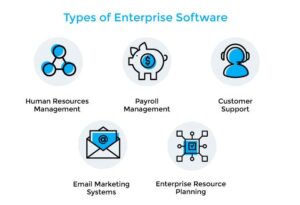
Enterprise applications are mobile apps (or software) that a company uses to complete its tasks. When the words enterprise and application are combined, it usually refers to a software platform that is too large and complex for individual or small business use.
What is the purpose of Enterprise applications?
Enterprise applications are intended to be essential components of a company’s information system. As a result, they typically handle a much broader and deeper range of functions and scale much higher than a smaller application. An enterprise application, rather than focusing on individual users or small teams, can serve entire teams and business divisions, interdepartmental needs, and even entire customer segments.
Enterprise applications (EAs) differ from typical applications in terms of the volume of data that is stored, processed, and otherwise managed. They can implement stricter security policies and have more administrative layers and permissions, as well as job cuts and risks.
Enterprise applications perform a wide range of functions to meet the diverse needs of a large enterprise with multiple departments. They should also be allowed to process large amounts of data quickly and be able to deploy across a range of networks. Medium to large businesses, government agencies, schools, interest-based user groups, clubs, charities, and other large organizations use enterprise applications.
Enterprise applications are usually a factor, distributed, scalable, complex, mission-critical, and operable from a single, centralized control panel to fulfill these needs. Large organizations may even combine several enterprise applications into a group of applications or a platform known as an enterprise system (ES).
And What’s The Vital Positive impact OF Enterprise applications?
Enterprise applications are critical to increasing the efficiency and productivity of business operations. EAs integrate information and operations across teams and departments and provide reporting and business intelligence to make better decisions by centralizing data as well as implementing controls.
EAs are fully customizable to better fulfill specific business needs, and large enterprises may struggle to organize business processes or meet regulatory requirements without them.
On How Enterprise applications operate?
Enterprise applications are built on an information system, which has a large amount of storage and processing power. Clients share data across departments or the entire enterprise, including remote locations. Multiple complex applications are integrated into systems, which are then combined into larger systems or platforms. EAs might be managed to install locally, delivered from the cloud, or a combination of the two. Provide for and Management of Enterprise Applications. Packaged enterprise application software (PEAS), an EA or ES offered as a package with some degree of customizability by an application service provider, is a common delivery method for enterprise applications (ASP).
Many EAs are cloud software as a service (SaaS) that third-party licenses to the enterprise and remote location provide and keep the software. In most cases, such PEAS can be customized by the provider, the customer, or a third party, but some enterprises need solutions that are so complicated, special, proprietary, or complies that one-out solutions are insufficient. Within that case, enterprises can choose to grow their own EA in-house or hire a third-party developer.
Categories OF Enterprise application;
The following are examples of valuable types of enterprise applications and their objectives:

- Software for Email Marketing;
Email marketing software automates the creation, delivery, and tracking of email campaigns. It is frequently integrated with a customer relationship management (CRM) platform to track contacts’ interactions with email campaigns and conversions.
- Software of Marketing;
Marketing automation requires an increasing interest in products and services by sharing relevant articles, videos, social media posts, e-books, podcasts, and other media, as well as serving advertisements. It is frequently implemented using a content management system (CMS), email marketing platform, social media platform, and other marketing tools.
- Software for Content Management;
A content management system (CMS) is used to generate, edit, store, and publish digital content like web pages, blog posts, downloadable digital assets, and images. Workflows, content organization, visitor and position administration, security, and other features are frequently supported.
- Customer Relationship Management;
CRM applications track and manage communications with customers via the web, email, phone, mobile apps, chat, social media, and corporate marketing materials.
- Software for Project Management
Project management software is being used to organize a company’s money to accomplish projects by implementing processes, tools, and knowledge. In the project management process, software tools developed specifically for organizing and tracking task completion, time, labor, costs, and other project resources and objectives may be used.
- Planning for Business Continuity;
BCP is really the planning and testing of measures that protect business operations while also allowing for the recovery of techniques in the event of facility loss, damage, or failure.
Enterprise Application Integration (EAI);
EAI connects enterprise application databases and workflows so that info is being used consistently and data changes are reflected throughout the organization.
- Enterprise Asset Management (EAM) ;
EAM manages the physical assets of the organization throughout its lifecycles. Applications and processes are used to optimize, continuously improve, and track asset maintenance work in regard to the tools, materials, skills, information, and priorities associated with them.
- Enterprise Resource Planning;
(ERP) is business process management software that enables an organization to handle its business and digitize many back-office functions related to technology, services, and human resources by utilizing a strategy to develop applications.
- Low-code and no-code development ;
provide a development platform in which software can be designed using a graphical user interface (GUI). With little or no coding expertise, perfectly functioning applications can be formed, making application development possible without coding expertise and thus less expensive and more efficient.
- Product Data Management (PDM);
is a centralized system that manages the production and publication of product data and process-related information. PDM is also known as version control in software engineering and not be confused with product information management (PIM).
- Product Information Management (PIM);
PIM gathers, manages, and empowers product information as well as the digital assets required to market and sell them through multiple distribution channels. PIM acts as a central system that controls information across teams in order to improve collaboration, efficiency, and consistency.
- Product Lifecycle Management (PLM);
PLM is related to the handling of products as they progress through the stages of their lifecycle, which include design, engineering, manufacturing, marketing, service, and disposal. PLM integrates various business systems and their data, processes, and inputs to assist companies in making pricing, promotion, and cost-effectiveness decisions.
- Business Intelligence (BI);
By combining data mining, data tools, data infrastructure, data visualization, trying to report, dashboard formation, and data analytics, BI enables businesses to make more data-driven decisions.
- Human Resource Management (HR or HRM);
Human resources management (HRM), also known as human capital management (HCM), aids in the direction of people through activities such as recruiting and selecting employees, hiring, deployment, training & development, performance evaluation, and pay and employee-benefits systems and design. HRM aids in the efficient use of labor, the reduction of risk, and the maximization of return on investment (ROI).
- Cybersecurity;
Cybersecurity applications safeguard computer systems against attacks that cause disclaimer, theft, or possible harm to electronic data, hardware, and software. Intrusion detection systems (IDS and IPS), software-defined networking (SDN), and security information and event management are all common approaches (SIEM).
- IT Services Management (ITSM);
ITSM helps in the implementation and management of an organization’s information technology services. Deploying and supporting EAs, architecting storage, networking, and cloud resources, and managing helpdesk support and troubleshooting procedures are all functions.
ITSM improves the quality of customer and employee experience and service by optimizing the design, creation, delivery, operation, and control of internal and external IT services.
- Forms Automation;
Enterprise forms automation is a method of management that organizes, distributes, completes, processes, and digitizes a wide range of important paper-based business documents. Forms, contracts, surveys, applications, and other materials fall into this category.
Forms automation is critical to lowering costs while improving data organization, consistency, accuracy, accessibility, analysis, and other advantages of a paperless office